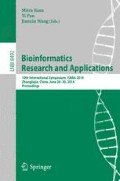Abstract
Particle selection from cryo-electron microscopy (cryo-EM) images is very important for high-resolution reconstruction of macromolecular structure. However, the accuracy of existing selection methods are normally restricted to noise and low contrast of cryo-EM images. In this paper, we presented an improved correlation method based on rotation invariant features for automatic, fast particle selection. We first selected a preliminary particle set applying rotation invariant features, then filtered the preliminary particle set using correlation to reduce the interference of high noise background and improve the precision of correlation method. We used Divide and Conquer technique and cascade strategy to improve the recognition ability of features and reduce processing time. Experimental results on the benchmark of cryo-EM images show that our method can improve the accuracy of particle selection significantly.
Access this chapter
Tax calculation will be finalised at checkout
Purchases are for personal use only
Preview
Unable to display preview. Download preview PDF.
References
Joachim, F.: Three-dimensional electron microscopy of macromolecular assemblies. Academic Press (1996)
Henderson, R.: The potential and limitations of neutrons, electrons and x-rays for atomic resolution microscopy of unstained biological molecules. Quarterly Reviews of Biophysics 28(02), 171–193 (1995)
Sali, A., Glaeser, R., Earnest, T., Baumeister, W.: From words to literature in structural proteomics. Nature 422(6928), 216–225 (2003)
Zhu, Y., Carragher, B., Glaeser, R.M., Fellmann, D., Bajaj, C., Bern, M., Mouche, F., de Haas, F., Hall, R.J., Kriegman, D.J., et al.: Automatic particle selection: results of a comparative study. Journal of Structural Biology 145(1), 3–14 (2004)
Hall, R.J., Patwardhan, A.: A two step approach for semi-automated particle selection from low contrast cryo-electron micrographs. Journal of Structural Biology 145(1), 19–28 (2004)
Mallick, S.P., Zhu, Y., Kriegman, D.: Detecting particles in cryo-em micrographs using learned features. Journal of Structural Biology 145(1), 52–62 (2004)
Zhu, Y., Carragher, B., Mouche, F., Potter, C.S.: Automatic particle detection through efficient hough transforms. IEEE Transactions on Medical Imaging 22(9), 1053–1062 (2003)
Yu, Z., Bajaj, C.: Detecting circular and rectangular particles based on geometric feature detection in electron micrographs. Journal of Structural Biology 145(1), 168–180 (2004)
Sorzano, C., Recarte, E., Alcorlo, M., Bilbao-Castro, J., San-Martín, C., Marabini, R., Carazo, J.: Automatic particle selection from electron micrographs using machine learning techniques. Journal of Structural Biology 167(3), 252–260 (2009)
Abrishami, V., Zaldívar-Peraza, A., de la Rosa-Trevín, J., Vargas, J., Otón, J., Marabini, R., Shkolnisky, Y., Carazo, J., Sorzano, C.: A pattern matching approach to the automatic selection of particles from low-contrast electron micrographs. Bioinformatics 29(19), 2460–2468 (2013)
Roseman, A.: Findema fast, efficient program for automatic selection of particles from electron micrographs. Journal of Structural Biology 145(1), 91–99 (2004)
Sigworth, F.J.: Classical detection theory and the cryo-em particle selection problem. Journal of Structural Biology 145(1), 111–122 (2004)
Orlova, E.V., Dube, P., Harris, J.R., Beckman, E., Zemlin, F., Markl, J., van Heel, M.: Structure of keyhole limpet hemocyanin type 1 (klh1) at 15 å resolution by electron cryomicroscopy and angular reconstitution. Journal of Molecular Biology 271(3), 417–437 (1997)
Kumar, V., Heikkonen, J., Engelhardt, P., Kaski, K.: Robust filtering and particle picking in micrograph images towards 3d reconstruction of purified proteins with cryo-electron microscopy. Journal of Structural Biology 145(1), 41–51 (2004)
Author information
Authors and Affiliations
Editor information
Editors and Affiliations
Rights and permissions
Copyright information
© 2014 Springer International Publishing Switzerland
About this paper
Cite this paper
Chen, Y., Ren, F., Wan, X., Wang, X., Zhang, F. (2014). An Improved Correlation Method Based on Rotation Invariant Feature for Automatic Particle Selection. In: Basu, M., Pan, Y., Wang, J. (eds) Bioinformatics Research and Applications. ISBRA 2014. Lecture Notes in Computer Science(), vol 8492. Springer, Cham. https://doi.org/10.1007/978-3-319-08171-7_11
Download citation
DOI: https://doi.org/10.1007/978-3-319-08171-7_11
Publisher Name: Springer, Cham
Print ISBN: 978-3-319-08170-0
Online ISBN: 978-3-319-08171-7
eBook Packages: Computer ScienceComputer Science (R0)

